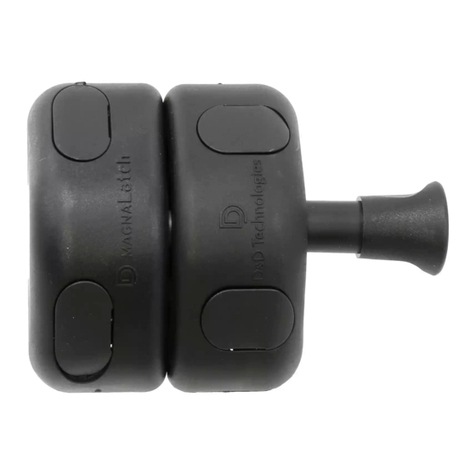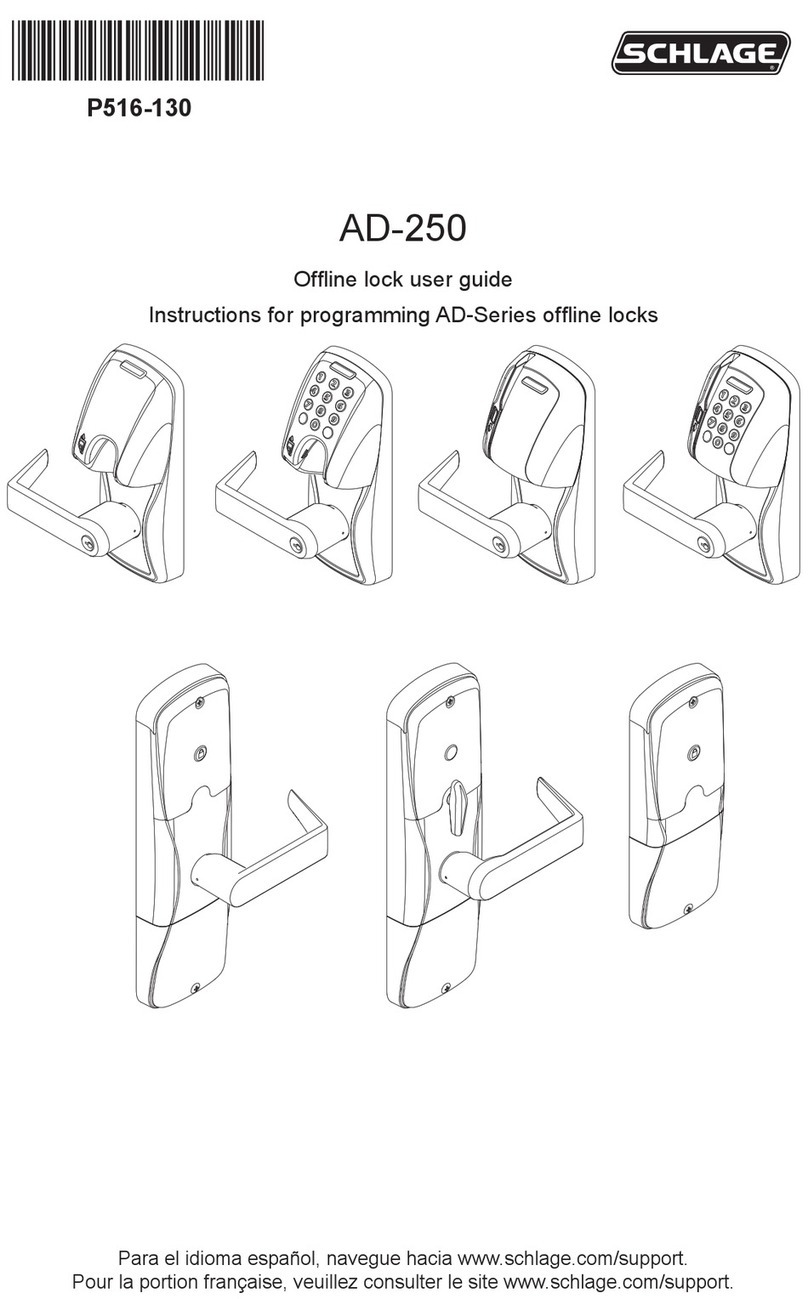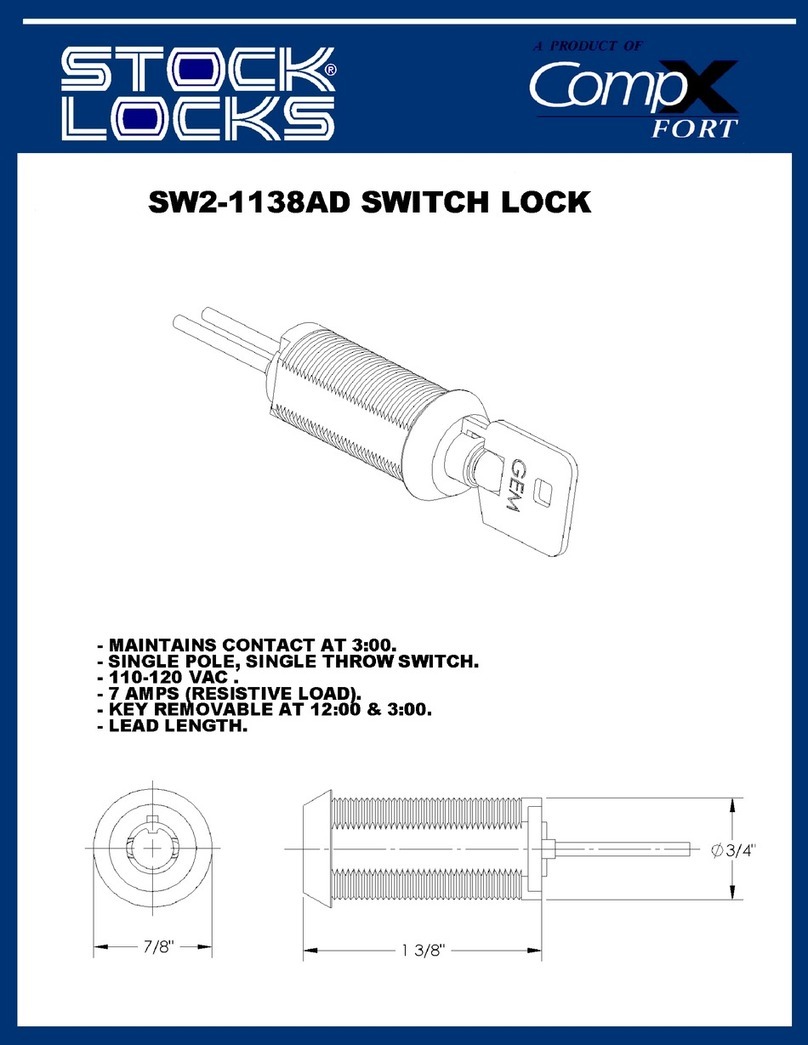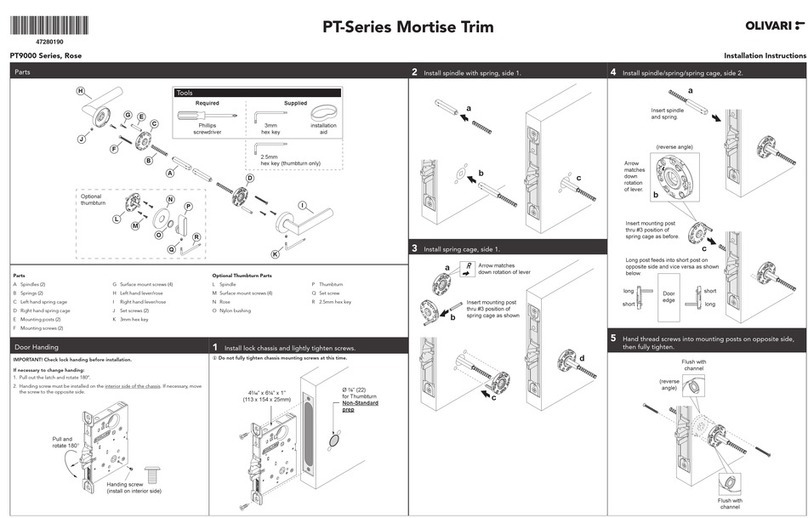BQT Solutions YD30D User manual

1
Installation and Operating Instructions
DN 01002/001 - 01/2023
YD30D Cobalt Double
Sideload Lock

2
Table of Contents
1. Document Information 3
1.1 Contents and Purpose 3
1.2 Target Group 3
2. Safety and Compliance 4
2.1 Safety Information 4
2.2 Regulatory Compliance Information 5
3. Product Information 7
3.1 Product Description 7
3.2 Package Contents 8
3.3 Technical Data 9
4. Product Dimensions 10
4.1 Lock Dimensions 10
4.2 Strike Dimensions 11
4.3 Housing Dimensions (Available Separately) 12
4.4 Dress Plate Dimensions (Available Separately) 12
4.5 Fitting Tab Dimensions (Available Separately) 13
5. Pre-Installation Assessment 14
5.1 Mounting Assessment 14
5.2 Wiring Assessment 15
5.3 Operating Mode Assessment 15
6. Mounting 16
6.1 Mortice Installation (Solid Wood) 16
6.2 Mortice Installation (Metal Extrusion) 17
6.3 Surface Mounting Installation (Solid Wood) 18
6.4 Surface Mounting Installation (Glass) 19
7. Wiring 20
7.1 Wiring Guide 20
7.2 Fail Safe Connection 20
7.3 Fail Secure Connection 20
8. Operating Mode 21
8.1 Fail Safe Operation 21
8.2 Fail Secure Operation 21
9. Maintenance 22
9.1 Maintenance and Cleaning 22
9.2 End of service life 22

3
1. Document Information
1.1 Contents and Purpose
This document describes installation, connection, operation, and maintenance of the lock YD30D.
Read the document carefully and observe the instructions it contains. They contain important
information for reliable installation and trouble-free operation.
1.2 Target Group
Target group of these instructions are:
• Installer
• Service Technician
Installers and service technicians are skilled personnel who have the specialist knowledge required for
installation, commissioning, and maintenance.

4
2. Safety and Compliance
2.1 Safety Information
WARNING
• Live parts inside.
• The handling and installation of this device is recommended for a professional.
• Use of an unsuitable power supply unit may cause product failure or injury.
• Do not remove the cover plates or face plate.
• Ensure installation does not expose sharp edges of the product to users.

5
2.2 Regulatory Compliance Information
This product is in compliance with the CE Directives including Electomagnetic Compatibility (EMC)
Directive, Restriction of the use of certain hazardous substances (RoHS) Directive, and Registration,
Evaluation, Authorisation and Restriction of Chemicals (REACH) Regulation.
EU Declaration of Conformity is available at www.bqtsolutions.com.
This product is in compliance with the United Kingdom (UK) Legislation including the Electromagnetic
Compatibility Regulation 2016, and the Restriction of the Use of Certain Hazardous Substances in
Electrical and Electronic Equipment Regulations 2012.
UKCA Declaration of Conformity is available at www.bqtsolutions.com.
This product is in compiance with the Regulatory Complaince Mark (RCM) for Australia and New
Zealand.

6
This device complies with Part 15 of the FCC Rules. Operation is subject to the following two condi-
tions:
1. This device may not cause harmful interference.
2. This device must accept any interference received, including interference that may cause undesired
operation.
Note: This equipment has been tested and found to comply with the limits for a Class B digital device,
pursuant to Part 15 of the FCC Rules. These limits are designed to provide reasonable protection
against harmful interference when the equipment is operated in a residential, commercial, or industrial
environment. This equipment generates, uses, and can radiate radio frequency energy and, if not
installed and used in accordance with the instruction manual, may cause harmful interference to
radio communications. However, there is no guarantee that interference will not occur in a particular
installation.
Modications:
void the authority granted to the user by the FCC to operate this equipment.
Innovation, Science and Economic Development Canada ICES-003:
CAN ICES-3(B)/NMB-3(B)
In the European Union, Norway, Iceland and Liechtenstein: This symbol on the product, or in the
manual and in the warranty, and/or on its packaging indicates that this product shall not be treated
as household waste. Instead it should be taken to an applicable collection point for the recycling of
electrical and electronic equipment.
By ensuring this product is disposed of correctly, you will help to prevent potential negative
consequences to the environment and human health, which could otherwise be caused by
inappropriate handling of this product.
In Countries Outside the European Union, Norway, Iceland and Liechtenstein: If you wish to dis-
pose of this product please contact your local authorities and ask for the correct way of disposal.

7
3. Product Information
3.1 Product Description
The YD30D is a motor driven low voltage electric lock designed to secure commercial and residential
swing-through (180°) doors. The lock has been designed to address the two biggest issues in
concealed electric locking today;
1. The ability to ‘pull’ a door into alignment even if the door has not closed in a central position.
2. The ability to release when requested even if there is excessive load on the door.
The design of the YD30D is unique as it has two motors which independently operate two bolt pins.
The bolt pins operate on a cam action which enables each bolt pin to pull a door into place. In practice
as the door closes it may come to rest in a position that is not fully closed. The YD30D senses when
from its resting position to the closed and secured position.
With the door secured and locked the YD30D can be given an unlock signal and it will instantly unlock.
If the door is loaded (pre-load) when the unlock signal is given the YD30D will still unlock, even with
loads in excess of 100kg on the door from either side. Critically the ability of the YD30D to instantly
release with excessive pre-load on the door even occurs in the event of a power failure if the lock is
Additional features of the YD30S are;
• Multi-voltage input (12 - 24VDC)
• Very low current consumption
• Door position and bolt position monitors
• High physical strength
• Fail-safe / Fail-secure on-site conversion with the re-positioning of a single switch

8
3.2 Package Contents
1x Lock 1x Strike Plate
4x 10G self-tapping screws 1x 300mm 7-way wire loom

9
3.3 Technical Data
Materials
Bolt Stainless Steel 17-4PH
Lock / Strike Plate Stainless Steel 304
Mechanical
Bolt Extension 13mm
Door Gap
Misalignment Correction
Cycle Life 1,000,000 cycles
Holding Force 10,000N (2,250 lbf) (factory tested)
Side Load Release 6,000N (1,350 lbf) (factory tested)
Locking Time 1.0 seconds (typical)
Unlocking Time 0.3 seconds (typical)
Electrical
Power Requirements 12-24 VDC ±15%
Initial Power Up Time 11 seconds
Initial Current Draw 750mA@12VDC, 400mA@24VDC
Standby Current 40mA@12VDC, 25mA@24VDC
Signal Contacts Bolt Position (NO) 30VDC max., 100mA max.
Door Position (NO)
Compliance
CE, UKCA, FCC, IC, RCM, RoHS 2

10
4. Product Dimensions
4.1 Lock Dimensions
The dimensions shown are approximate and subject to change without prior notice.
183mm
7.205in
47mm
1.854in
3mm
0.118in
255mm
10.039in
10mm
0.394in
235mm
9.252in
10mm
0.394in
30mm
1.181in

11
4.2 Strike Dimensions
The dimensions shown are approximate and subject to change without prior notice.
255mm
10.039in
100mm
3.937in
55mm
2.165in
14mm
0.551in
3mm
0.118in
10mm
0.394in
235mm
9.252in
10mm
0.394in
30mm
1.181in

12
4.3 Housing Dimensions (Available Separately)
The dimensions shown are approximate and subject to change without prior notice.
259mm
10.205in
56mm
2.189in
220mm
8.661in
20mm
0.787in
34mm
1.346in
4.4 Dress Plate Dimensions (Available Separately)
260mm
10.236in
58mm
2.283in

13
4.5 Fitting Tab Dimensions (Available Separately)
The dimensions shown are approximate and subject to change without prior notice.
38mm
1.476in
24mm
0.945in
20mm
0.787in
M5x0.8 Thread
4mm
0.157in

14
5. Pre-Installation Assessment
5.1 Mounting Assessment
Mortice installation ensures a discrete solution as the lock and strike plate can be embedded into
the door leaf and frame, however in some instances this is not possible. Glass doors for example
require surface mounting which is done with the aid of the YD30D housing and dress plate (available
separately).
The lock and strike plate can be installed morticed (1), surface mounted (2), or a combination of the
two (3). Regardless of the installation method it is vital that the lock face plate and strike plate are
the door is closed.
either direction and the YD30D will pull the door into alignment with ease. This misalignment could be
caused by an automatic door closer not aligning the door or natural distortions in the door assembly.

15
5.2 Wiring Assessment
Before installation begins, consideration must be made for where to run the wires and decide on
what feedback is required from the lock. There are a total of seven available connections; three are
compulsory power/control connections whilst the remaining four provide optional door and bolt position
feedback. These optional connections can be integrated into access control or alarm systems to
provide full monitoring.
The correct gauge of wire needs to be chosen as voltage drop across the power/control wires can limit
the locks operation. For all the remaining connections, a lower gauge wire can be used as these are
only signal wires. The following table shows the maximum distance that the wire runs can be between
the power supply and the lock, assuming the power supply outputs 12VDC or 24VDC.
Conductor Cross Sectional Area Maximum Distance
#AWG (mm²) at 12VDC at 24VDC
24 0.20 10m (33ft) 30m (98ft)
22 0.33 16m (52ft) 48m (157ft)
20 0.52 26m (85ft) 77m (253ft)
18 0.82 41m (135ft) 122m (400ft)
16 1.31 65m (213ft) 195m (640ft)
14 2.08 103m (338ft) 310m (1017ft)
5.3 Operating Mode Assessment
The YD30D can be set to one of two operating modes before installation, Fail Safe or Fail Secure.
When the operating mode is set to Fail Safe, supply voltage is applied to the control input to lock the
door, and the YD30D will unlock in the event of power loss.
When the operating mode is set to Fail Secure, supply voltage is applied to the control input to unlock
the door, and the YD30D will lock or remain locked in the event of power loss.
The failure mode of the YD30D is factory set as Fail Safe. Before the lock is installed this can be
changed to Fail Secure by repositioning the switch located at the end of the product.

16
6. Mounting
6.1 Mortice Installation (Solid Wood)
1. Cutting the mortice
Referring to the product dimension drawings, a mortice
frames require full mortices with space made behind the
lock body to accommodate the wire connections.
It is crucial to ensure that the mortices in the door leaf
and frame are aligned vertically and horizontally when
the door is closed as this aligns the bolt pin to the strike
opening and also the strike magnet to the locks internal
door position sensor.
strike plate once it is installed will be no more than 6mm
2. Wiring the lock
A hole needs to be drilled in the back of the mortice to
bring the wires out and a connection can be made to the
supplied wire loom which in turn plugs into the lock.
Refer to the Wiring section of this document for detailed
instructions on wiring.
3. Setting the operating mode
Ensure the operating mode switch is positioned to the required
state, Fail Safe or Fail Secure.
Refer to the Operating Mode section of this document for
detailed instructions on wiring.
4. Fitting the lock and strike plate
The lock can be slid back into the door frame mortice, ensuring
that the wiring integrity is maintained, and then secured in place
with the supplied 10G self-tapping screws. Please ensure the
lock is the correct orientation as to pull the door into the door
jamb.
The strike is then placed into the door leaf mortice and the
remaining 10G self-tapping screws are used to secure it in
place. Ensure the strike is oriented so that the bolt hole aligns
with the lock bolt.

17
6.2 Mortice Installation (Metal Extrusion)
1. Cutting the mortice
Referring to the product dimension drawings, a mortice is
being hollow, often only require a single rectangle cut-out to
accommodate the lock face plate or strike plate. For these
(available separately).
It is crucial to ensure that the mortices in the door leaf and
frame are aligned vertically and horizontally when the door
is closed as this aligns the bolt pin to the strike opening and
also the strike magnet to the locks internal door position
sensor.
strike plate once it is installed will be no more than 6mm
2. Wiring the lock
Feed the wires out of the hollow chamber of the frame and a
connection can be made to the supplied wire loom which in
turn plugs into the lock.
Refer to the Wiring section of this document for detailed
instructions on wiring.
3. Setting the operating mode
Ensure the operating mode switch is positioned to the required
state, Fail Safe or Fail Secure.
Refer to the Operating Mode section of this document for detailed
instructions on wiring.
4. Fitting the lock and strike plate
The lock can be placed into the door frame cutout, ensuring that
the wiring integrity is maintained, and then secured in place with
M5 machine screws (included with tting tabs). Please ensure the
lock is the correct orientation as to pull the door into the door jamb.
The strike is then placed into the door leaf cutout and then M5
machine screws (included with tting tabs) are used to secure it in
place. Ensure the strike is oriented so that the bolt hole aligns with
the lock bolt.

18
6.3 Surface Mounting Installation (Solid Wood)
1. Preparing the mounting surface
Install two 10Gx1” self-tapping screws (included with housing) in
the mounting surface, as per the product dimension drawings they
should be 220mm apart, 20mm from the surface edge.
2. Preparing the housing
An 8mm hole should be drilled through the housing wall at the
position chosen by the installer for the wiring to enter. The wiring
can be guided to the housing through surface mount conduit, or
through a hole in the mounting surface material. Push a rubber
grommet (included with housing) over the drilled hole to protect the
wires from any sharp edges.
3. Fitting the housing
Position the keyhole cutouts of the housing over the screw heads
screws in place to secure the housing.
4. Wiring the lock
Feed the wires through the 8mm hole in the housing and a
connection can be made to the supplied wire loom which in turn
plugs into the lock.
Refer to the Wiring section of this document for detailed
instructions on wiring.
5. Setting the operating mode
Ensure the operating mode switch is positioned to the
required state, Fail Safe or Fail Secure.
Refer to the Operating Mode section of this document for
detailed instructions on wiring.
6. Fitting the lock and strike plate
The lock can be placed into the housing, ensuring that the
wiring integrity is maintained, and then secured in place with
M5 machine screws (included with housing). Please ensure
the lock is the correct orientation as to pull the door into the
door jamb.

19
6.4 Surface Mounting Installation (Glass)
1. Fitting the housing
Clean the glass surface with isopropyl alcohol and
peel the protective layer from the double sided tape
edge of the glass, and press down to adhere tape to
surface.
2. Fitting the dress plate
Clean the glass surface with isopropyl alcohol and
peel the protective layer from the double sided tape
the edge of the glass and centered on the housing
location, and press down to adhere tape to surface.
3. Fitting the strike plate
The strike is then placed into the housing and then
secured in place with M5 machine screws (included
with housing). Ensure the strike is oriented so that
the bolt hole aligns with the lock bolt.

20
7. Wiring
7.1 Wiring Guide
The YD30D is supplied with a 7-way wire loom that plugs directly into the lock. The wires are colour
coded as per table below, with the power and control wires being essential connections and the four
monitor connections being optional.
Wire Colour Meaning Description
RED Power Supply
(12 - 24VDC)
Positive connection to DC power supply, “+”
BLACK Negative connection to DC power supply, “-”
BLUE Control Switched positive control input
VIOLET Bolt Position
Monitor
Normally open contact (NO), closed when the bolt pin is
extended (optional)
VIOLET
WHITE Door Position
Monitor
Normally open contact (NO), closed when the strike is
aligned with the lock (optional)
WHITE
7.2 Fail Safe Connection
lock (active-high locking signal). In the event of a power cut, the YD30D will unlock.
7.3 Fail Secure Connection
unlock (active-low locking signal). In the event of a power cut, the YD30D will remain locked.
This manual suits for next models
1
Table of contents
Popular Lock manuals by other brands

Dorma
Dorma ARCOS Office Mounting instructions

Motormate
Motormate Honda 10-401-SS installation instructions
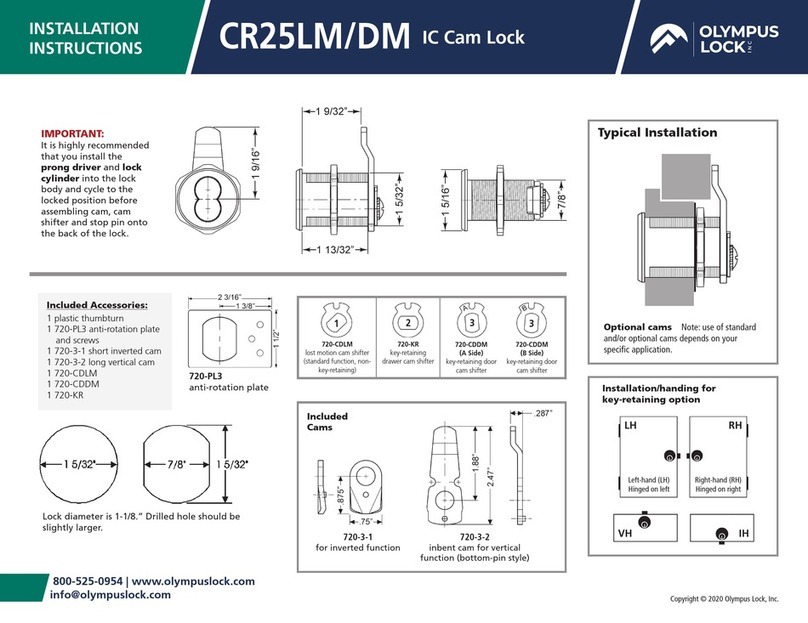
Olympus Lock
Olympus Lock CR25LM installation instructions

deconta
deconta ECO-Line instruction manual
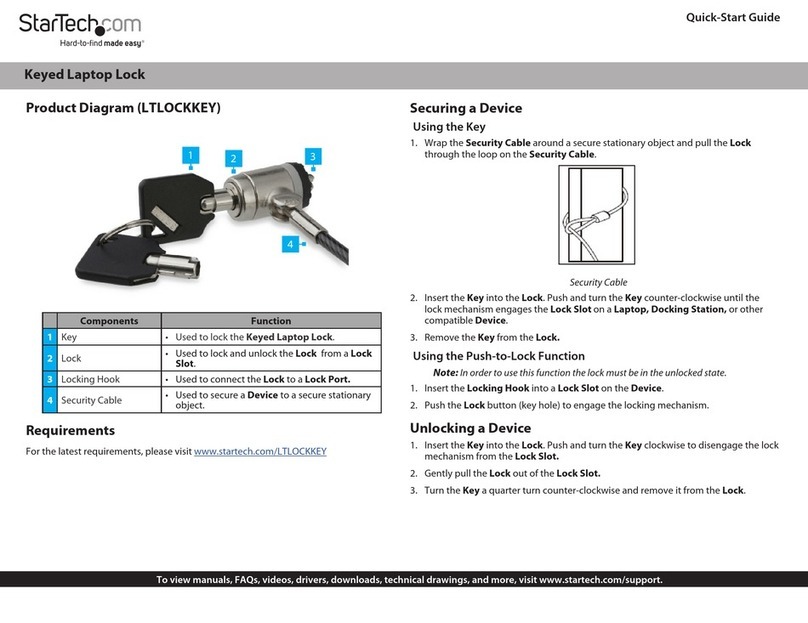
StarTech.com
StarTech.com LTLOCKKEY manual

Yale
Yale Real Living Assure Lock YRD226 Installation and programming instructions

Simons Voss Technologies
Simons Voss Technologies PegaSys 2.1 quick guide
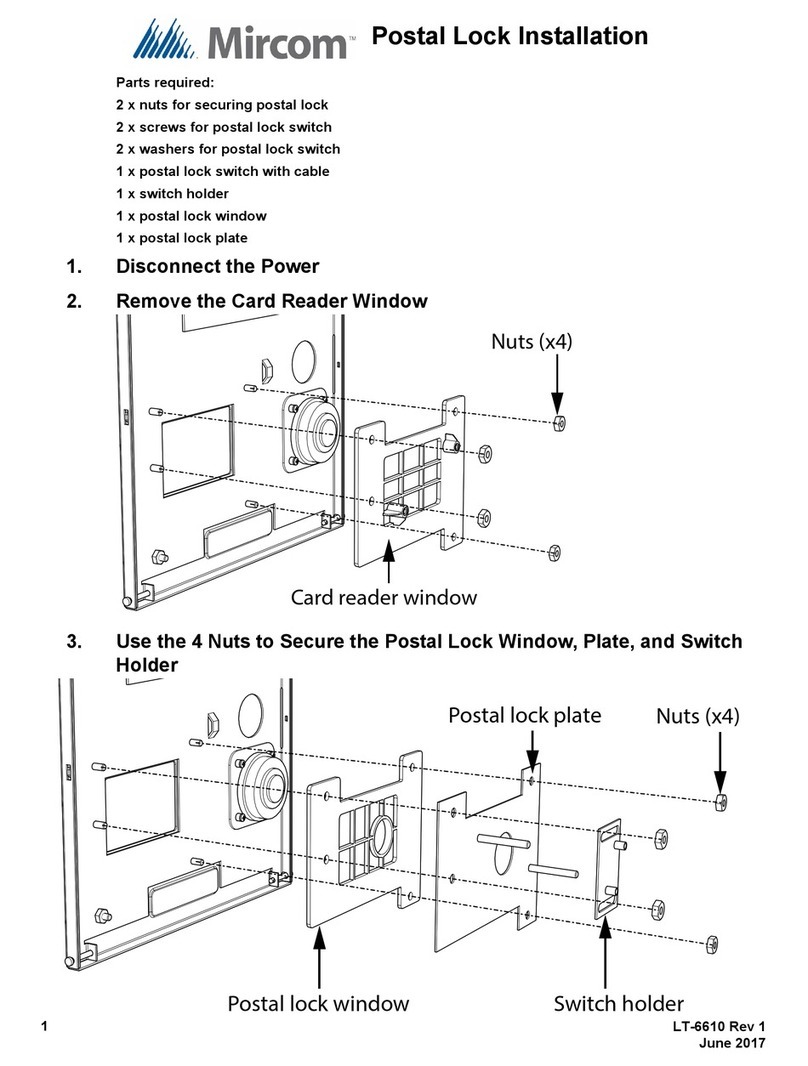
Mircom
Mircom LT-6610 installation manual

YLI
YLI YM-500 Wiring instructions
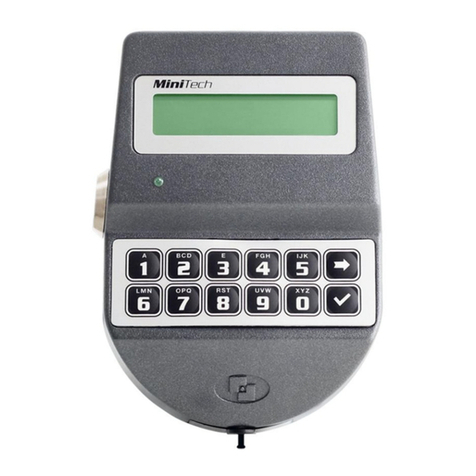
Tecnosicurezza
Tecnosicurezza MiniTech User operating instructions
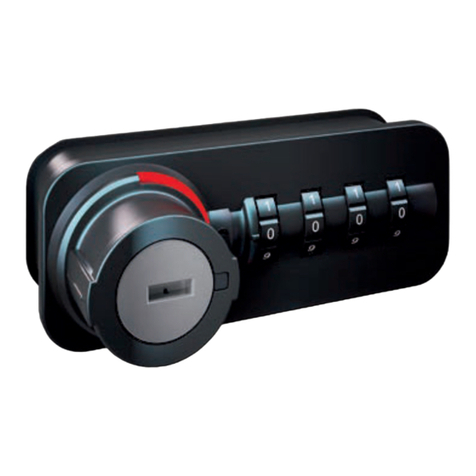
Edsbyn
Edsbyn 59 manual
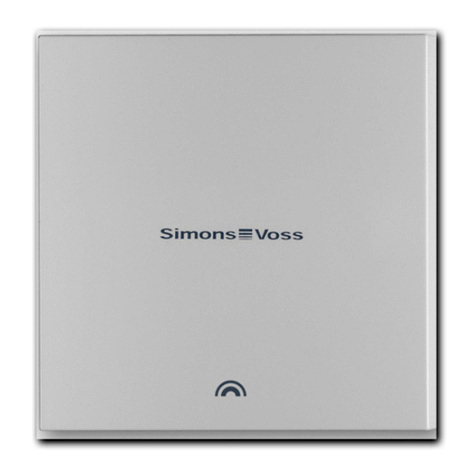
Simons Voss Technologies
Simons Voss Technologies LockNode SREL2.G2 quick guide

